Table of contents
- Visit to two Batavus collectors Code name Starflite
- Built-in motors from Sachs, ILO or Villiers
- Batavus Bilonet was the mega-seller in 1950
- Distribution network through German department stores
- Starflite GT 50 in MOTORCYCLE test in 1972
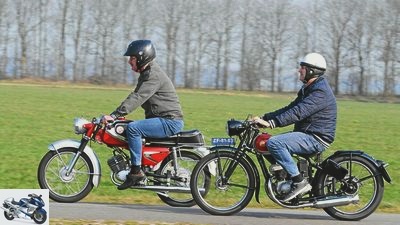
Siemer

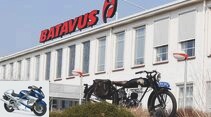
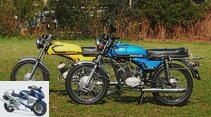
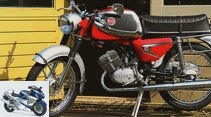
21 pictures
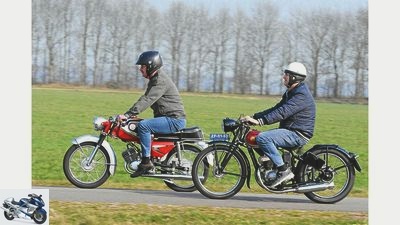
Siemer
1/21
We visited two insiders on Batavus motorized bikes. Here on the road with Starflite GT 50 and Batavus ILO 125.
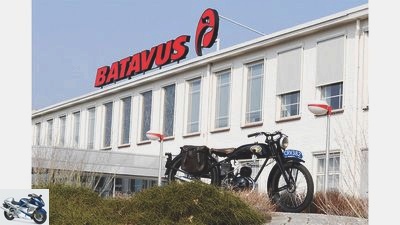
Siemer
2/21
Here the Batavus ILO 125 from 1940 poses in front of today’s factory.
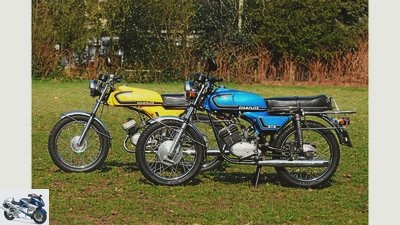
Siemer
3/21
Department store goods? No way, the Mokick GTM and the GTS 50 moped are hotly coveted Starflite icons today.
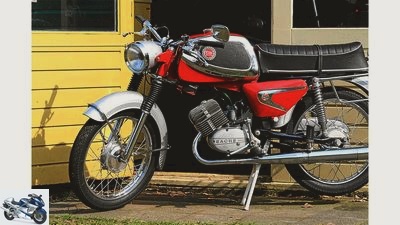
Siemer
4/21
The first moped export hit was the Starflite GT 50, and MOTORRAD also received a lot of praise for it. Mainly because of their Sachs engine.

Siemer
5/21
How good that Jappie doesn’t collect BMW. Then – with the same fun factor – he would have had to cultivate a long time ago.
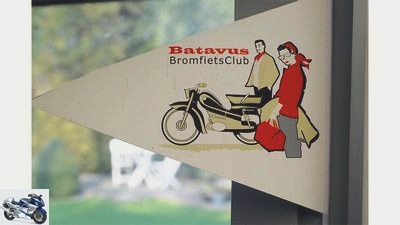
Siemer
6/21
Advertising for the Bromfiets has lost none of its charm.
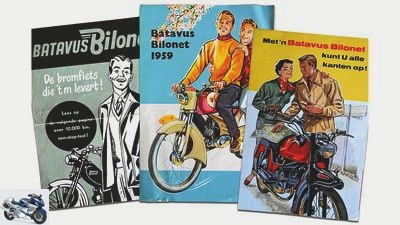
Siemer
7/21
The advertising goes down even if the language is not immediately understandable.
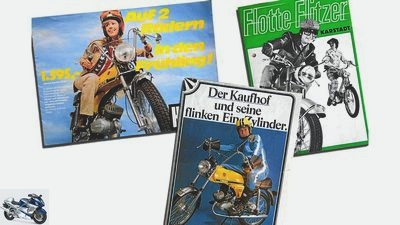
Siemer
8/21
Soon the Holland motorcycles from the department store were no longer inferior to the competition, especially Starflite mopeds.
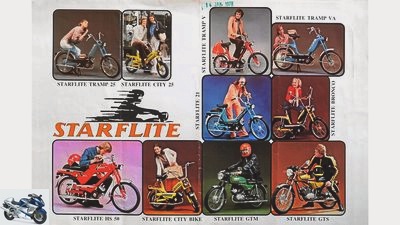
Siemer
9/21
The Dutch often act pragmatically: In their densely populated country it didn’t have to be a motorcycle.
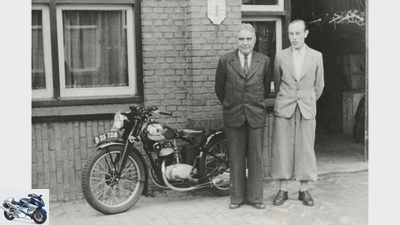
Siemer
10/21
Founder Andries Gaastra (left) and his son Gerrit made Batavus great.
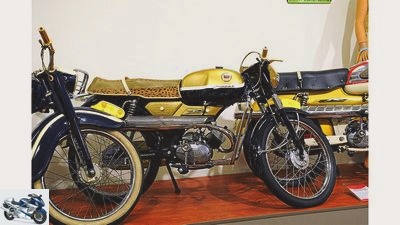
Siemer
11/21
The Dutch boyhood dream and the cult Bromfiets par excellence: The Whippet appeared in a new outfit every year.
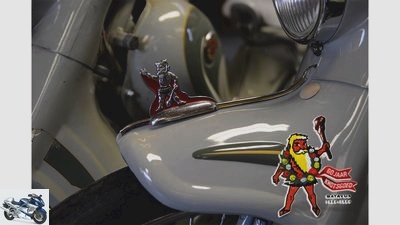
Siemer
12/21
Just like the motorcycle itself.
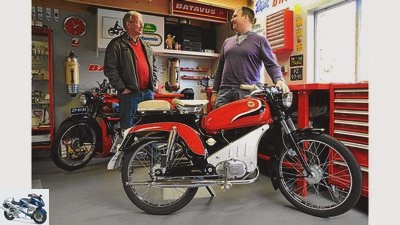
Siemer
13/21
Wietze (left) and Jappie at the workshop.
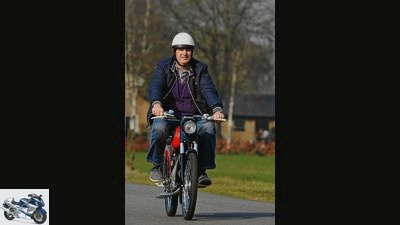
Siemer
14/21
Bromfiets driving (see text for explanation) demands a very unique style: Jappie and the great Bilonet G-50 Sport from 1958.

Siemer
15/21
The successful model in its most beautiful form: the much sought-after Bilonet Supersport from 1966.
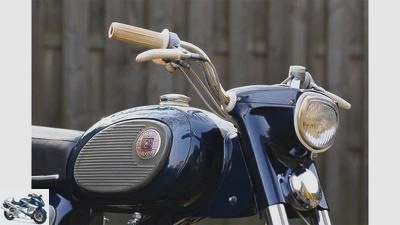
Siemer
16/21
Bilonet Supersport.
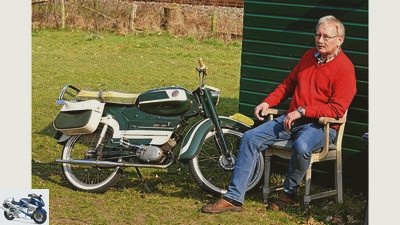
Siemer
17/21
After work with Bromfiets. The 63 Bilonet G-50 Combisport with optional luggage bags.
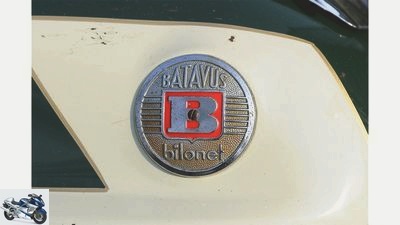
Siemer
18/21
Bilonet G-50 Combisport.
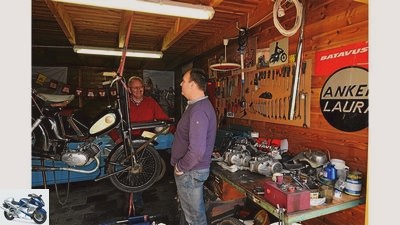
Siemer
19/21
Small truck: Batavus trucks used to be part of the Dutch street scene. And today in every collection.

Siemer
20/21
The mascots also belong in the collection.
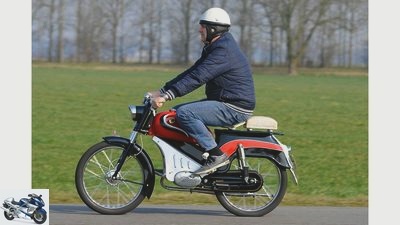
Siemer
21/21
And even after more than 55 years, the motorcycles continue to delight. One end is not foreseen.
Sports & scene
Starflite Batavus motorcycles from Holland
Visit to two Batavus collectors
Code name Starflite
Content of
The Batavians once settled the coastal area along the mouth of the Rhine. Their successors later flooded all of Europe with Batavus bicycles. Under the name of “Starflite” they even brought motorbikes to Germany. A visit to two insiders.
Fred Siemer
06/11/2015
Many Asterix friends must now be very brave: It was not the Gauls, but Germanic warriors who succeeded in conquering a Roman legionary camp for the first time. That was around 70 AD, during the Batavian uprising, but has a noticeable effect up to our time: namely, Andries Gaastra, a thirsty, very young businessman from Heerenveen, was all too fond of remembering his resilient ancestors, whose settlement area would soon be large the present-day Netherlands included. The Latin name of his homeland is derived from the name of their tribe. Batavia. And what Gaastra intended to sell from 1909 onwards really affected all of the Batavians. Cycles. His should therefore be called Batavus.
Buy complete article
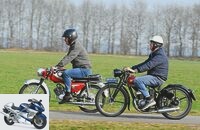
Visit to two Batavus collectors
Code name Starflite
8 pages) as PDF
€ 2.00
Buy now
Wietze Jonker is also part of this long history. And Wietze can tell stories. Definitely through Batavus, he’s been working there since 71. Oh, since 1971. The bicycle manufacturer is now part of the Accell Group, but is still the largest employer in Heerenveen. Wietze has been working on the assembly line for a number of years; today, as head of the production preparation department, he ensures that everything runs smoothly. Which parts are needed exactly, where are they stored, how do they come to be assembled? Something like that. The 61-year-old goes to work by bike, but he could actually walk too. When he gives himself away from work – within sight of the plant – he likes to screw things up. On a fat Chrysler or a slightly less fat Guzzi. Mostly on dainty Batavus, and very few of them don’t have a motor.
Built-in motors from Sachs, ILO or Villiers
In 1930, Andries Gaastra and his son Gerrit agreed to put their business on several pillars because of the global economic crisis and to manufacture transport motorcycles and motorcycles up to a maximum of 150 cm³ in addition to bicycles. From 1932 onwards, usable and fine designs were built around built-in engines from Sachs, ILO or Villiers, and just like comparable light motorcycles in Germany, they soon sold splendidly. With prosperity slowly rising again, the simple Dutchman could dream of a Batavus motorcycle at the end of the 30s. In 1938, the model with a 125 cm³ Sachs engine including a chrome-plated tank cost 277 guilders. Legshields were 7.50 guilders extra, a speedometer 15. Wietze Jonker can only laugh about that today: Every few days he scours the Internet for relevant offers – and shakes his head at the prices called up.
They hit him hard because Wietze got hit hard. He collects, and this is how it happened: Because Andries Gaastra had been making watches and sewing machines for a number of years before he started cycling, in 2004 Heerenveen celebrated the 100th anniversary of his company. On this occasion, everything that Batavus had manufactured in the way of bicycles, load carts and motorcycles paraded through the city. Wietze Jonker saw this Concours d‘elegance and was amazed. Yet he had witnessed the last 13 years of motorcycle production – it ended in 1984 – and had assembled mopeds and mokicks himself for three years. But this diversity here knocked him out. So moving seemed to him what had been built, especially in the 50s and 60s. Every year a new design, a slightly different technology. Definitely other colors. He also wanted to enjoy such bromine fights in the future.
Because that was them, most of the motorcycles passing Wietze: Bromfietsen. This is what our neighbors used to call everything that has cranks and, because of its limitation to a maximum of 40 km / h and 50 cm³, anyone over the age of 16 was allowed to drive. And that also on bike paths. A laudably simple regulation, which has meanwhile been changed umpteen times, but at that time increased the popularity of the Bromfietsen enormously. The things were there for everyone. But they weren’t the same for everyone: while the workers went for the Werkmansbrommer with a pragmatic two-speed engine and young hotspurs for the Schakelbrommer with at least three gears, the feminine Damesbrommer had an automatic. What Batavus did not care, because in Heerenveen all wishes were taken into account.
Batavus Bilonet was the mega-seller in 1950
After all, Batavus was one of the pioneers of this movement. When the first real Bromfietsen appeared on Holland’s cycle paths towards the end of the 1940s, Gerrit and Hans Gaastra immediately recognized their potential. Like all Western Europeans, the Dutch strived for motorized vehicles, but in their densely populated homeland it didn’t necessarily have to be a large motorcycle. The Gaastra brothers – their father died in 1945 – set up a high-performance production facility with great vigor and in 1950 presented the mega-seller of the following decade, the Bilonet. B for Batavus, ILO for the built-in motor used, net as characterization. Because it was nice, so much so that bilonet clubs were founded all over the country in the 1950s. It quickly varied its initially moped-like figure, soon appeared stocky with only a hint of step-through or decidedly sporty with a proper saddle tank and self-confident color scheme.
Such a Bilonet G-50 Sport, built in 1958, is driven by Wietzes friend Jappie de Vries, born in 1965. The cheerful man is a printer, only works occasionally for Batavus, and yet: His exquisite collection includes a good 20 Heerenveen motor vehicles, each of them in first-class condition. most of them finely restored by himself. The Sport-Bilonet is just one of its stars, for the photo Jappie gives her the spurs: 40 km / h. Both know that such a bilonet can be very different. After all, one of the common marketing instruments in the 1950s was to advertise the qualities of a motor vehicle by bravely passing long-distance journeys. So the bilonets came around the world; one made it to Baghdad, the next to Alexandria, Morocco was as little left out as the USA. Hugo de Wijs is the name of the globetrotter whom Batavus repeatedly supported with a small budget and who couldn’t get enough of big trips in his small 50s.
Distribution network through German department stores
If you didn’t have as much time as Hugo, you could ask for your bilonet at home. For example with the very popular Bromfietsgrasbaanraces. Yes, you read that right. The Dutch also practiced off-road sports with their beloved Brommers, and Batavus often enough drove ahead. A small sports department was set up, kindly supported by Gerrit Gaastra – he has been the sole director of the plant since the death of his brother in 1950 – and some enthusiasts built some really sharp off-road equipment there. However, they then carried Sachs engines from 50 to 125 cm³ and were spotted at the International Six-Day Race, where even gold medals were won. The same circle later developed the daring idea of competing in sprint races and setting the 125cc world record there themselves. That didn’t quite work out, but Wietze Jonker is still proud that this high-flyer is in his garage today.
Fat years back then, Batavus produced a good 70,000 motorized two-wheelers around 1970. More than half were exported, and of course the German market played no small role in this. Unfortunately there was a problem: At home it was – and is! – Batavus as a real premium brand. In Germany, however, you had to sell based on price because of the strong competition from local manufacturers. On the other hand, it seemed unreasonable for the good compatriots to have to discover on vacation on the Moselle that, for example, the valued Batavette moped cost less in Trier than in Amsterdam. There was also a lack of a powerful sales network. The solution? Batavus used large department store chains as partners, and Starflite was emblazoned on the tanks of mopeds, mopeds and mopeds. This brand name in turn goes back to a very successful Batavus bicycle from the 1950s. The trick worked great, thousands of Dutch bikes crossed the border via Hertie, Horten and Co..
Some of these are particularly popular with collectors such as Wietze and Jappie. In Holland there were no special legal regulations for stronger 50s. What was called a moped in this country and could be driven at 16 already fell under motorcycle and required the appropriate driver’s license. As a result, such devices are still very rare in their country of origin. Batavus did not give up on it for a long time, but benefited from the acquisition of the Magneet brand in 1969. Their model Magneet Thunderbird with its sporty line was the starting point for a moped from Heerenveen. It appeared in 1970 with a five-speed Sachs engine, was called the Batavus TS 49S and remained on sale until 1975.
Starflite GT 50 in MOTORCYCLE test in 1972
For the reasons mentioned, the name change soon followed, when MOTORRAD went to the test for issue 5/1972, the new child was already called the Starflite GT 50. In the slogan Ernst Leverkus wrote “Warenhaus-Motorrad”, then a hymn of praise for the engine to this sober entrance to follow. Two years later, on the GTS 50, Batavus had upgraded the chassis with a Marzocchi fork and received the following verdict from Franz Josef Schermer in issue 2/1974: “Starting with the Sachs engine, the chassis parts and the nicely fancy equipment the Starflite GTS 50 offers just as much as the competition. ”However, the Batavus merchants could not do magic, the price difference to German offers was seldom more than three or four hundred. They were easily undercut by the Japanese and some Italians. With the mopeds, however, the Dutch quickly developed into a great power. Image did not play an important role here, but quality, fresh colors and chic designs all the more. Tiny wheels, bonanza handlebars – whatever they wanted was built.
Today, fashionable late works are less popular than export rarities such as GTS and GT 50 or classics from the prewar period and the golden years of the Bromfietsen. That is why Wietze and Jappie like to linger in the Batavus factory museum with the graceful motorcycles of the 1930s. However, the two really bright eyes when they bend down to the Whippet. This Brommer was a cult, it was a dream, a drug, and Batavus pinned the boys on with new details every year. Raised exhaust system, handlebar trim, three-color tank with additional chrome surface, bench in leopard decor, small lampshade over the headlight – a single indulgence. As standard with a Dutch peculiarity: both pedals can be fixed in the lowest position after pedaling. This increases the comfort enormously, as the two collectors can confirm: trips from their Batavus Bromfietsclub often lead over more than 100 kilometers. And yes, that was great fun. If only all veteran friends were so wonderfully playful and unpretentious.
Related articles
-
Tips for buying used motorcycles with over 100,000 kilometers
Herder 21 pictures Lohse 1/21 Aglasterhausen, Ducati ST2, EZ 4/2002, 121,766 km. Lohse 2/21 Actually a tragic case. Ducati is building a famous tourer…
-
The most beautiful motorcycles
motorcycles The most beautiful motorcycles The most beautiful motorcycles Ideal lines It is said that beauty is in the eye of the beholder. Nevertheless,…
-
Motorcycles not coming in 2007
11 pictures Yamaha 1/11 Yamaha 2/11 Yamaha 3/11 Yamaha 4/11 Yamaha 5/11 Say 6/11 Yamaha 7/11 Yamaha 8/11 Yamaha 9/11 Yamaha 10/11 Yamaha 11/11…
-
Sound experience on motorcycles
motorcycles Sound experience on motorcycles Sound experience on motorcycles The ear goes with you Motorcycling as a sensual event starts at the top. And…
-
Scene: People and their motorcycles
fact motorcycles Scene: People and their motorcycles Scene: People and their motorcycles In the beginning it was the curve Regardless of whether it’s a…
-
Podcast MOTORRAD Rider # 1: Motorcycles for little people
Dina Dervisevic counselor Driving experience & Driving tips Podcast MOTORRAD Rider # 1: Motorcycles for little people Podcast MOTORRAD driver episode 1…
-
New noise regulation for motorcycles from 2016
Motorcycle noise Debate about the volume of motorcycles Photo: fact 8th pictures Chaqune 1/8 Moto Guzzi driver Holger Siegel is the spokesman for the…
-
Spotlight: Motorcycles from China
archive counselor traffic & business Spotlight: Motorcycles from China Spotlight: Motorcycles from China China: danger or opportunity? In terms of…
-
Frequent drivers: people and their motorcycles
to travel Frequent drivers: people and their motorcycles Frequent drivers: people and their motorcycles Saddle Festival On the way to the meeting, no way…
-
Traffic hooligans in Great Britain: motorcycles in the scrap press
Northamptonshire Police counselor traffic & business Traffic hooligans in Great Britain: motorcycles in the scrap press Traffic hooligans in the UK…